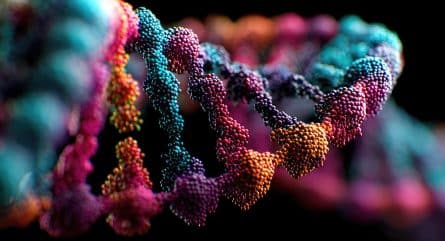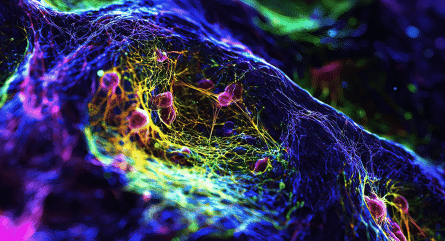The takeaway: What two scientists established the structure of DNA? And why does it really matter? On this important 70th anniversary, we explain it for you.
In 1953, writing in Nature, scholars James Watson and Francis Crick penned what would turn out to be quite the understatement: “This structure has novel features which are of considerable biological interest.”
Who were these two? Francis Harry Compton Crick was an English molecular biologist who studied at Cambridge and got his start in science measuring the viscosity of water at high temperatures. The destruction of his lab during the Battle of Britain redirected his scholarly pursuits, however, and by the late 1940s he was working at Cambridge and with colleagues at King’s College London, where he met James Watson. Watson was a Chicago-born scholar who studied at the University of Chicago and Indiana University and later made his way to Cambridge.
What the two discovered in 1953–with the help of many others—was the double helix structure of DNA.
When was DNA discovered? Identifying the double helix
In 1953, both Crick and Watson were building on research that described a model of the amino acid alpha helix using X‑ray crystallography and molecular model building. They were both chasing heady ideas—Crick sought to discover how the brain made a conscious mind, while Watson was pursuing the physical nature of genes.
The identification of the double helix structure of DNA was made in mid-March—the two men used experimental data collected by Rosalind Franklin, whose work was not attributed. Their paper, “Molecular structure of nucleic acids: A structure for deoxyribose nucleic acid,” was published in Nature on April 25, 1953, and it described in general terms how the DNA helix carries genetic information from one generation to the other. Nine years later, in 1962, Watson and Crick, along with Maurice Wilkins, were awarded the Nobel Prize for their finding. Today, exactly 70 years later, this finding continues to impact science.
What did Watson and Crick discover? That DNA was not a three-helical structure
As they noted in the introductory paragraphs of their report, Watson and Crick were building off recent work by scientist Linus Pauling, who in 1954 won a Nobel prize for his work with chemical bonds and the structure of molecules and crystals. Earlier in 1953, Pauling published a paper proposing that DNA had a triple-helical structure.
The model “consists of three intertwined chains, with the phosphates near the fibre axis, and the bases on the outside,” Crick and Watson wrote. “In our opinion, this structure is unsatisfactory for two reasons.”
Those two reasons were the belief that the material they saw in X‑ray diagrams was salt, not a free acid, which would not hold the structure together, and that distances used in earlier estimations were incorrect.
“We wish to put forward a radically different structure for the salt of deoxyribose nucleic acid,” they wrote, before describing both in words and in an image the exact same standard coiled double helix that we use today—that famous image, by the way, was drawn by Crick’s wife, Odile, who was an artist.
Implications of the discovery of the DNA double helix
What did Watson and Crick discover? At its core, the scientists discovered how it was possible for genetic instructions to be held inside organisms and then passed from generation to generation. But that was just the beginning, since the establishment of the double helix paved the way for a huge range of developments including the rise of modern molecular biology and the backbone of our current understanding of ourselves and much of the world around us. This finding is a symbol for how we understand ourselves, what influences our behavior, and what the future may hold.
While Watson and Crick received well-earned praise for their discovery, many have argued that a third person deserved an equal share of the credit—Franklin. Franklin was born in 1920 and eventually pursued a PhD in physical chemistry at Cambridge. She later became an accomplished X‑ray crystallographer, and it was her foundational work that paved the way for Watson and Crick. Why did she not get the same merit? In part, because she died in 1958 of cancer, and Nobel rules stipulate that all awardees be living, meaning many never learned of the role her work played in the important scientific breakthrough.
Crick went on to win numerous awards and pioneer more work. He also held some controversial views on eugenics. In 2016, the Francis Crick Institute opened in London, while the Francis Crick Medal and Lecture was established in 2003. Crick wrote numerous books, including Of Molecules and Men. He died at the age of 88 in San Diego.
Watson, too, led an illustrious life after his double helix finding. In 1968, he published the book The Double Helix, which was highly praised. It told the story of the discovery of the structure of DNA as well as some of the conflicts and controversy surrounding the work. Crick objected to the book, and the two had a falling out. In 1990, Watson was appointed head of the Human Genome Project at the National Institutes of Health, and in 1994 became president of Cold Spring Harbor Laboratory (CSHL). He, too, made comments that drew criticism, including about sexuality, race, and body weight. In 2007, he became the second person to publish his fully sequenced genome online in hopes it would spur the development of personalized medicine. In 2014, he sold his Nobel prize medal as a protest against criticism for the controversial statements he had made—it sold at auction for $4.1 million, though it was later returned to him by the purchaser.
IDT keeps the spirit of discovery alive
Watson and Crick’s discovery of the double helix gave rise to Integrated DNA Technologies. As a champion of the life sciences for more than 30 years, IDT has focused on developing and manufacturing nucleic acid products that support the life sciences industry. IDT is a leader in the manufacture of custom oligos, including single-stranded DNA, primer pools, and duplex DNA. IDT boasts a vertically integrated synthesis platform largely developed in-house all to ensure fast turnaround times and the most demanding oligo requests.
Perhaps the product most closely tied to Watson and Crick’s discovery is IDT’s gBlocks™ and gBocks HiFi Gene Fragments, which are double-stranded DNA fragments up to 3000 bp in length and designed for affordable and easy gene construction or modification.
To learn more, visit IDT’s oligo ordering site.
*RUO—For research use only. Not for use in diagnostic procedures. Unless otherwise agreed to in writing, IDT does not intend for these products to be used in clinical applications and does not warrant their fitness or suitability for any clinical diagnostic use. Purchaser is solely responsible for all decisions regarding the use of these products and any associated regulatory or legal obligations.



























